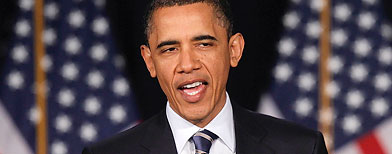Even with all of these cuts and tax raising, cutting 4 Trillion from americas 14+ TRILLION dollar debt would still leave 10+ TRILLION to deal with. Instead of cutting like some serial killer, maybe he should think about restoring MANUFACTURING TO AMERICA. That will end the job issue, the debt issue, the borrowing money from other nations issue, the unemployment issue etc etc.

Wed Apr 13, 2:13 pm ET
Key from the speech: What’s in Obama’s deficit reduction plan?By Zachary Roth

By Zachary Roth zachary Roth – Wed Apr 13, 2:13 pm ET
After largely staying on the sidelines during the fight over the deficit, President Obama today jumped headfirst into the fray, laying out a broad framework to reduce the federal budget gap by $4 trillion over the next 12 years.
In a speech at George Washington University in Washington, D.C., Obama proposed what he called a "balanced approach," a mix of spending cuts and tax increases "that puts every kind of spending on the table, but [...] protects the middle class, our promise to seniors, and our investments in the future." he said.
The plan contrasts with one released last week by Rep. Paul Ryan of Wisconsin, the Republican point man on budget issues. Obama derided Ryan's approach as "less about reducing the deficit than it is about changing the basic social compact in America."
Here's what Obama called for in his "Framework for Shared Prosperity and Shared Fiscal Responsibility": * One quarter of the deficit reduction to be achieved through tax increases, with the rest to come mostly from spending cuts--a split
that the president's liberal base may see as still too heavily tilted toward spending cuts
* An end to the Bush tax cuts for the 2 percent of Americans making $250,000 or more
* Tax reform aimed at closing loopholes that favor the rich, allowing for a lowering of overall rates, as recommended by the Bowles-
Simpson deficit reduction commission
* Cuts of $770 billion by 2023 to non-security discretionary spending, another Bowles-Simpson recommendation
* Cuts of $400 billion to "security spending"--that is, defense--by 2023
* A rejection of the Ryan budget's approach to Medicare and Medicaid, which the White House believes would unfairly shift costs to
seniors and the vulnerable while undermining both programs in the long term. Instead, Obama proposed reforms to reduce the
growth of health care spending (beyond those in the overhaul last year) that would save $480 billion by 2023, and at least an
additional trillion in the decade following
* Cuts to other mandatory programs--the White House listed agricultural subsidies, the federal pension insurance system, and
anti-fraud measures--worth $360 billion by 2023
* A general effort to "strengthen Social Security for the long haul," without slashing benefits for future generations
* A "debt failsafe," to kick in by 2014. If long-term deficit projections aren't looking better by that time, the failsafe would trigger an
across-the-board spending reduction (with exceptions for Social Security, low-income programs, and Medicare benefits)
* The creation of a committee chaired by Vice President Joe Biden and including members of both parties and houses of Congress, to
begin meeting next month in order to "agree on a legislative framework for comprehensive deficit reduction"
http://news.yahoo.com/s/yblog_thelookout/20110413/ts_yblog_thelookout/key-from-the-speech-whats-in-obamas-deficit-reduction-plan